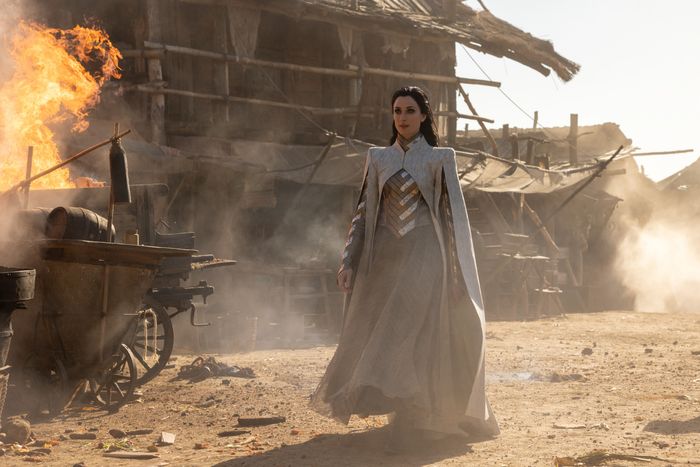
More villains should be dominatrix-style sex goddesses who stride around magical netherworlds wearing wide-legged pants, obsessed with the Chosen One because they want to be in bed with them all the time.
Photo: Prime Video
It started a few weeks ago. Friends and colleagues chatting over texts and direct messages, casually slotting it into conversation. “Hey, is Wheel of Time … good now?” There is some exhaustion that inevitably follows this kind of observation. Maybe it was good, but no one has time to wait for a show to improve in its second season. If it can’t pull itself together by episode five of the first, wouldn’t a viewer’s time be better spent with a show that’s excellent from the jump? Except now, in October of 2023, peak TV has already peaked and a summer of strikes has taken a hit on the fall release schedule. Not only that, but the post–Game of Thrones era of massive TV fantasy has proven to be distinctly lackluster. Suddenly, a show that figures itself out in season two becomes a more interesting prospect!
So it is my duty to report that yes, it’s true. In its second season, the Amazon fantasy series Wheel of Time, based on the unending Robert Jordan novels that start out like a Lord of the Rings rip-off, is a TV series that has figured itself out. Much like an enormous wheel of fate that turns throughout the generations, bringing its heroes low so they can one day triumph, TV has delivered unto us a pretty fun high-fantasy romp! Let us give thanks and praise.
In fairness, any story with a pseudo-medieval setting, a complicated system of magic, and a villain bound to end the world unless a hero rises to stop them is going to encounter the same obstacles at the start. It’s going to feel both too familiar (Oh really? That nice young man with a humble background is the only person who can save the world? You don’t say!) and too opaque (There’s a complex magical system based on … weaving? And only some people have it but others don’t and also some people have wolf magic?). Wheel of Time’s second season feels much more relaxed and confident in no small part because it doesn’t have to deal with all that place setting anymore. It’s a huge relief.
But if that alone were enough to guarantee improvement, everything from The Witcher to Shadow and Bone to His Dark Materials would have rip-roaring season twos, and that has not been the case. What distinguishes Wheel of Time is threefold. Its villains got better. It made bold decisions to depart from the books. And most importantly, it figured out how to explore meaningful character arcs within several divided plots, arcs that made each of the characters more interesting and emotionally complex before bringing them all together at the end.
First, Lanfear. Honestly, more villains should be dominatrix-style sex goddesses who stride around the netherworlds wearing wide-legged pants, obsessed with the Chosen One because they want to be in bed with them all the time. No more Skeletor-style baddies whose primary grudge seems to be their annoyance with how gruesome they are, and no more mysterious Dark Lords whose faces are never glimpsed by Mortal Men. Between Lanfear and her Forsaken brother (colleague?) Ishamael, and the new terrifying threat of the Seanchan (slavers with extravagant makeup looks), Wheel of Time’s second season provided embodied villains with fantastic wardrobes and weird hang-ups. It’s so important to have someone around to actively participate in the conflict. Looming, shadowy doom is only fun for so long.
Like so many adaptations, Wheel of Time’s first season suffered for its sense of loyalty to the original text. Season two’s significant departures, especially the Barbie-and-Ken style himbo-abandonment dynamic between Moiraine and her bodyguard Lan, created room for a freedom and playfulness that season one notably lacked. Moving away from the original source text gives the show the sense that it’s being powered by its own engines rather than drawing all its energy from something it feels beholden to obey.
That adaptive freedom also means season two has more wiggle room in general and can build a balanced escalation for each of its central characters over the season. Egwene and Nynaeve have more time to connect as novices before Nynaeve undergoes her big Accepted trial, and this period spent together becomes a vital foundation for how both characters face crises later on. Rand and Lanfear have plenty of room to be freaky together before Lanfear is revealed as a baddie. This also creates more freedom to leave some characters out of the story until their roles are interesting again. What’s Mat doing imprisoned in the Tower this whole time? We don’t really care! We get a check-in to find out where he is, and then we can leave that story alone until Wheel of Time decides it’s ready to break him out.
The total effect of all those changes is that Wheel of Time is simply more fun than it was before. It consistently understands what’s most interesting about each of its key characters, it doesn’t demand a lot of patience before getting to the good part of a story, and it knows how to balance all of its plotlines for tone, timing, and forward momentum. If all this sounds like the basic, competent storytelling necessary for any TV show: yes! That still puts Wheel of Time’s second season solidly above most fantasy TV over the past few years. The IP keeps rolling out, and the wheel keeps turning. This time, thank goodness, it’s in the right direction.
This post was originally published on this site be sure to check out more of their content.







